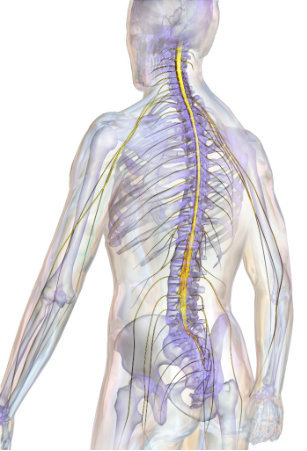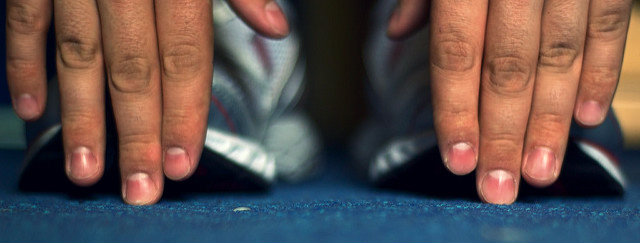 Reading Time: 6 minutes
Reading Time: 6 minutesThe American Chiropractic Association estimates 31 million Americans will suffer from back pain in their lives. An alarming statistic that tells us back pain is a mainstay in American culture. We all have it, share it, and without talking much about it, are looking to solve it.
But you are different. You do your daily workout, go to yoga twice a week, walk the dogs, and then in a lazy attempt to get things done, you bend over to pick up the laundry and there is it, your back goes out.
The majority of the time, people do not hurt their backs in the middle of a one-rep max deadlift. They do it picking up laundry or their kids when their focus is not 100%.
When you are in the gym, you can recite the commands for a perfect deadlift, but in real life something goes wrong. Somewhere in the system of your body, your default movement patterns are not wired properly — and you probably have more in common than you knew with those bobblehead dolls.
Lucky for you, there’s an easy fix. You just need a little practice.
First, What Is Pain?
Before we can discuss low back pain, we first need to understand pain. Our bodies are a system of systems. We have a cardiovascular system, musculoskeletal system, nervous system, and the list goes on. What you will not find, however, is a pain system.
 Pain is a result of your brain telling your body it is in danger. You only feel pain when your brain recognizes a threat to its survival. Break an arm in nature, and you are in trouble. Your brain is going to let you know. Put your spine in a position where it is in danger, and you will have back pain. Do it all the time — and now you have chronic back pain.
Pain is a result of your brain telling your body it is in danger. You only feel pain when your brain recognizes a threat to its survival. Break an arm in nature, and you are in trouble. Your brain is going to let you know. Put your spine in a position where it is in danger, and you will have back pain. Do it all the time — and now you have chronic back pain.
The spine is the lightning rod in charge of delivering directions from our brains to our bodies. It is important.
The spine runs from the base of our head down to our tailbone. Think about the spine as a stick connecting our upper and lower body. If the lower half and the upper half do not move together as a unit, that stick has a risk of breaking.
If your brain recognizes any sort of threat on the spine, it will shoot pain to your leg that can put you on the ground.
Are You a Bobblehead Doll?
Yes, those fun figurines that are usually athletes or public figures. They have a huge head held on by a spring and a lower body that is little and stationary. If someone walks by or bumps the desk they sit on, the head of the doll will bounce around.
The bobblehead doll effect is the root cause of back pain. Your upper body and lower body are not moving as a unit, just like the doll. That lack of connectivity is recognized by your brain as a threat.
That threat is expressed as back pain.
The 3 Most Common Systemic Problems
When we think about pain as a connectivity dysfunction caused by poor movement and a lack of brain-body awareness, it changes the way we diagnose and treat that pain. Instead of treating symptoms, we can explore the systemic problems and movement patterns that are causing the brain to tell the body it is in danger.
So what are the largest systemic problems that lead to poor movement and low back pain?
- Brain Body Connection: Most people sit a lot throughout the day. When you sit, you rarely use your posterior chain (glutes, hamstrings, and back.) Not using that musculature creates imbalances. The brain senses these imbalances as a threat to the spine. As a whole, we need to sit less and move more.
- Stress: Mental and emotional stress create tension. That tension is stored in our musculature. Tight muscles, even just 5% tighter than normal, will hinder the body’s ability to move through proper and full ranges of motion. If we are not strong and stable at our end ranges of motion, then dropping down in a squat while working out or bending over too quickly to pick up laundry will wreak havoc on our low back.
- Mobility and Stability: Can you bend over and touch your toes with straight legs? If not, you lack mobility in your tissues and your movements will be compromised at end ranges of motion. Can you get your palms to the ground? If yes, you have too much mobility, potentially lack stability, and will struggle controlling your joints as they pass end ranges.
The 3 Solutions to Your Low Back Pain
If back pain is a hindrance to your life, the solution cannot be even harder to execute or there is no way it will be sustainable. The key to solving low back pain comes down to making small, sustainable changes that develop into habits and become the default patterns of your lifestyle (sounds a lot like the Whole Life Challenge to me).
There is a different solution to each of the three most common problem scenarios I described above:
- Brain Body Connection: Slow down your movement practice. Instead of doing exercises for time or for the most weight, do them for quality. It is hard to measure quality, but your brain will connect with your movement and develop a stronger connection to your limitations when you move slower.
- Stress: Download the Headspace app, find ten minutes in your day to create space for yourself, and focus on your breath. The body has a built-in down-regulation system called the parasympathetic nervous system. The breath is the easiest way to activate it and ten minutes a day is a great start to alleviating the tension stored in your tissues.
- Mobility and Stability: We need them both, but not too much of either. You want to be able touch your toes, twist, and extend your arms overhead without pain. Find your limitations and create a plan to develop those ranges of motion. For ideas, check out the WLC library of mobility and yoga videos.
Start Solving Your Low Back Pain Today
Wherever you are reading this, squeeze your glutes and abs, pull your ribs down, and roll your shoulders back and down. Close your eyes and count your breath — three seconds in, hold for three seconds, and three seconds out. Repeat this sequence five times.
In just 45-seconds, you have started connecting your brain and body, relieving tension the body has been holding on to, and creating stability in the spine. Do not be a bobble head doll. Find balance, move well, and start living pain free.







